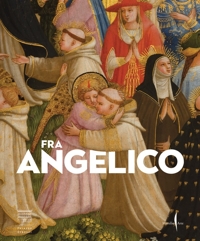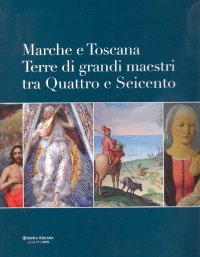Beato Angelico
Firenze, Palazzo Strozzi, 26 settembre 2025 - 25 gennaio 2026.
A cura di Carl Brandon Strehlke.
Testi di Stefano Casciu, Marco Mozzo, Angelo Tartuferi.
Venezia, 2025; ril., pp. 456, 300 ill. col., cm 24x29.
prezzo di copertina: € 80.00
|
Libri compresi nell'offerta:
Beato Angelico
Firenze, Palazzo Strozzi, 26 settembre 2025 - 25 gennaio 2026.
A cura di Carl Brandon Strehlke.
Testi di Stefano Casciu, Marco Mozzo, Angelo Tartuferi.
Venezia, 2025; ril., pp. 456, 300 ill. col., cm 24x29.
OMAGGIO (prezzo di copertina: € 80.00)
Marche e Toscana. Terre di grandi maestri tra Quattro e Seicento
Ospedaletto, 2007; ril., pp. 320, ill. col., tavv. col., cm 25,5x29.
OMAGGIO (prezzo di copertina: € 77.00)
Segni dell'Eucarestia
A cura di M. Luisa Polichetti.
Ancona, Osimo, Loreto Jesi, Senigallia, Fabriano e Metelica, 23 giugno - 31 ottobre 2011.
Torino, 2011; br., pp. 221, ill. b/n e col., cm 24x28.
OMAGGIO (prezzo di copertina: € 32.00)
Diagrams. A Project by Amo/Oma
Progetto Prada Arte
Venezia, Ca' Corner della Regina, 10 maggio - 24 novembre 2025.
A cura di Mario Mainetti.
Introduzione di Miuccia Prada.
With Italian translations.
Graphic Design: Irma Boom.
Testo Inglese.
Milano, 2025; br. in cofanetto, pp. 448, 369 ill. col., cm 21x28.
ISBN: 88-87029-94-6 - EAN13: 9788887029949
Soggetto: Architetti e Studi,DigitalArt,Fotografia,Pittura,Saggi (Arte o Architettura),Scultura
Periodo: 1960- Contemporaneo
Testo in: 
Peso: 1.05 kg
"Diagrams" is an exhibition project conceived by AMO/OMA, the studio founded by Rem Koolhaas, for the Fondazione Prada Venice venue, Ca' Corner della Regina, investigating the visual communication of data as a powerful tool for constructing meaning, comprehension or manipulation and a pervasive instrument for analyzing, understanding and transforming the surrounding world. It seeks to foster dialogue and speculative reflection on the relationship between human intelligence, scientific and cultural phenomena, and the creation and dissemination of knowledge.
The exhibition, on view on the ground and first floors of the 18th-century Palazzo Ca' Corner della Regina, gathers more than 300 items, including rare documents, printed publications, digital images, and videos, spanning from the 12th century to the present day and related to various geographical and cultural contexts. This material is displayed according to a thematic principle that reflects not only contemporary world urgencies but also, de facto, demonstrates the diagram's transversal and diachronic nature. The exhibition system, designed by AMO/OMA according to the "now urgencies" principle, is structured according to nine primary topics: Built Environment, Health, Inequality, Migration, Environment, Resources, War, Truth, and Value. These themes are illustrated in the central room of the first floor in a series of vitrines arranged in parallel to one another.
The project benefits from the extensive research conducted by Fondazione Prada in close collaboration with Rem Koolhaas and Giulio Margheri, Associate Architect at OMA. The expertise of Sietske Fransen, Max Planck Research Group Leader, Bibliotheca Hertziana - Max Planck Institute for Art History, was instrumental.
As stated by Rem Koolhaas, "In my view, the diagram has been an almost permanent tool. For example, in the early stages of our research, we discovered three-dimensional diagrams from South Africa dating back to 40,000 BCE, as well as wood-carved maps of the Greenlandic coastline made on the island of Ammassalik. This demonstrates that the diagram is an enduring form of communication that adapts to whatever medium exists at the time. Regardless of the medium, a diagram serves didactic (explanatory) or suggestive (persuasive) purposes. This means that it not only exists by default in any new medium but can also be applied to virtually any area of human life. Fashion, religion, or the history of social inequality can be interpreted as a diagram. I deeply enjoy this interdisciplinary aspect of the diagram, its invariable attribute-its independence from language (words) makes it one of the most effective forms of representation."
The continuous interplay between the ancient and the modern, which defines the exhibition's narrative, fosters a reflection that intertwines the form and content of diagrams. Infographic communication formally evolved in the 20th century, influenced by historical avant-gardes. Modernism's significant contributions to visual communication enable a retrospective reassessment of the formal, aesthetic, and artistic qualities of ancient and pre-modern infographics.
Central to the exhibition is also AMO/OMA's design practice, which has integrated diagrammatic forms as architectural tools since the 1970s. As Koolhaas explains, "Complex ideas are almost an intellectual or sometimes artistic pleasure, and they became a driving element in what we were trying to do. In this context, diagrams were incredibly helpful. By researching and designing them, we were trying to form a space or to define another architecture, the form of which required an enormous amount of argument and articulation.
We would not have come close to that if I had not discovered a number of diagrams. The role of diagrams was crucial at that time because we needed the physical burden of proof to show that what we wanted to achieve was possible. Today, I may find myself in a different position, where I no longer have to prove that things are possible, and that certainly changes the nature or the role of diagrams. But I would still say that diagrams are an important part of my repertoire."
The exhibition also includes the contributions of other significant and recent environmental design and urbanism practices developed by international platforms like Atmos Lab and Transsolar, as well as by investigative practices and scholars such as Theo Deutinger and SITU Research.

Quante strade. Bob Dylan e il mezzo secolo di «Blowin'in the wind»
Friuli Venezia Giulia Sguardi sull'acqua / Glimpses of its water
Brescia. Uno sguardo senza tempo sul centro storico della città
Artists and Pirates. Satirical Prints in Georgian London and Dublin










